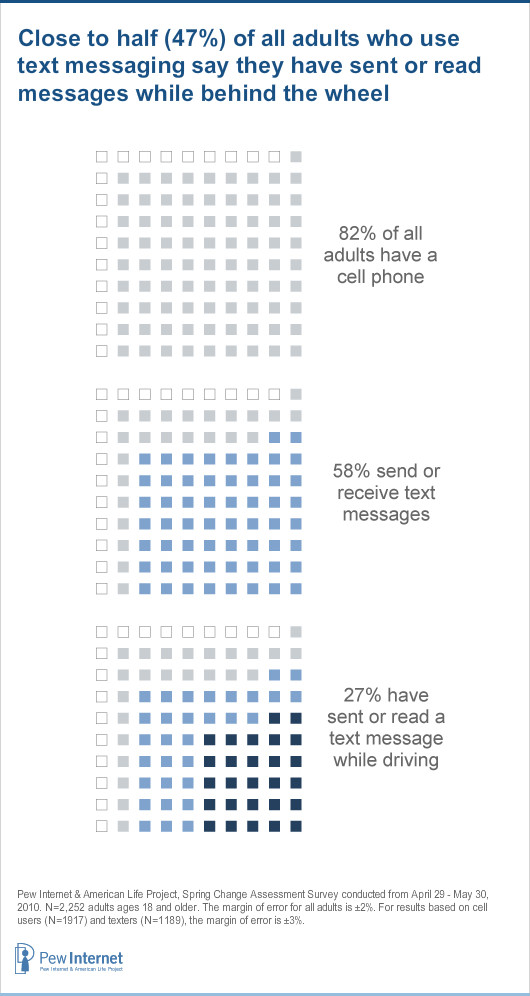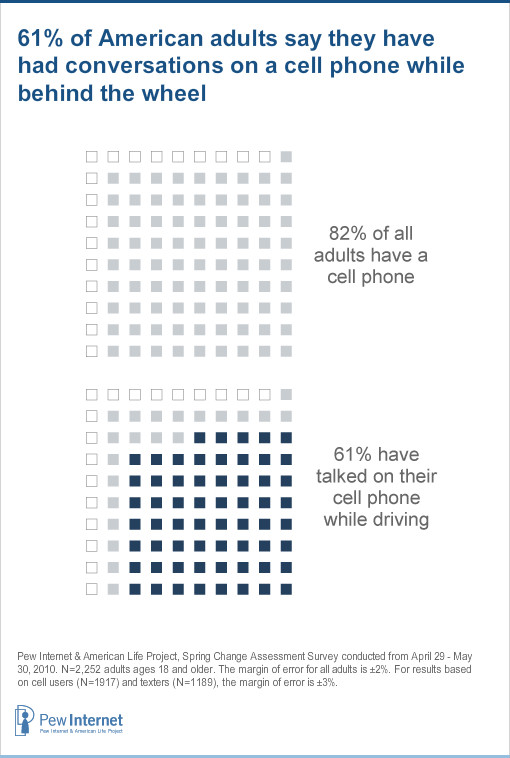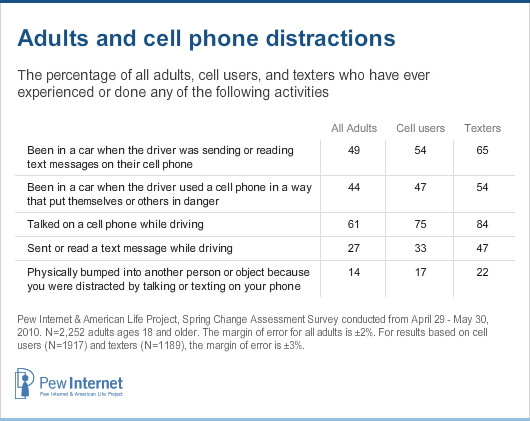47% of texting adults say they have sent or read a text message while driving
Close to half (47%) of all adults who use text messaging say they have sent or read messages while behind the wheel. That compares to one in three (34%) texting teens ages 16-17 who said they had “texted while driving” in our September 2009 survey.
In the general population this means that 27% of all American adults say they have texted while driving.
Male texters are more likely to report texting at the wheel; 51% of men who use text messaging say they have sent or read messages while driving while 42% of women texters say the same.
Those in the Millennial generation (ages 18-33) are more likely than any other age group to report texting while driving. While 59% of texting Millennials say they have sent or read messages at the wheel, 50% of text-using Gen Xers (ages 34-45) and 29% of texting Baby Boomers (ages 46-64) report the same.

75% of cell-owning adults say they have talked on a cell phone while driving
Three in four cell phone-owning adults say they have talked on a mobile phone while driving. That compares to just half (52%) of cell-owning teens ages 16-17who reported talking on a cell phone while driving in our 2009 survey.
In all, 61% of American adults say they have had conversations on a cell phone while behind the wheel.
Again, men are more likely than women to report this distraction; 78% of cell-owning men say they have talked while driving, compared with 72% of cell-owning women.
Eight in ten cell-using Millennials say they have talked on their mobile phones while driving. However, Gen X stands out as the group most likely to chat at the wheel when compared with older generations. While close to nine in ten (86%) Gen Xers who own cell phones talk while driving, just 73% of Boomer cell owners and 50% of those age 65 and older say they talk on their phones while at the wheel.
Parents are more likely than non-parents to say they have talked on a cell phone while driving; 82% of cell-owning parents report this, compared with 72% of non-parents.

49% of all adults say they have been in a car when the driver was sending or reading text messages on their cell phone
Half of all American adults (49%) say they have been passengers in cars with other texting drivers. The same proportion (48%) of all teens ages 12-17 said they had been in a car “when the driver was texting” in our 2009 survey.
Men and women are equally as likely to say they have been in a car when the driver was texting. However, non-white American adults are more likely than whites to say they have been passengers of texting drivers. While 56% of black adults and 58% of Hispanic adults say they have been passengers of texting drivers, 46% of white adults report the same.
The likelihood that someone will be a passenger of a texting driver decreases dramatically with age. While one in three (75%) Millennials say they have been passengers in a car with a texting driver, 59% of Gen Xers, 37% of Boomers and just 18% of adults age 65 and older say they have had that experience.
Parents are considerably more likely than non-parents to say they have been passengers of distracted drivers; 58% all parents say they have been passengers when the driver was texting, compared with 45% of non-parents.
44% of all adults say they have been in a car when the driver used the cell phone in a way that put themselves or others in danger
While cell phones are most commonly used for talking and texting, there is a range of other potentially distracting behaviors—such web browsing, video watching, picture-taking and gaming—that can divert a driver’s attention away from the road. In all, 44% of adults say they have been passengers in a car with a driver who used a cell phone in a way that put themselves or others in danger. About the same number of teens (40%) said they had been in a car when the driver used a cell phone in a dangerous way in the 2009 survey.
Men are more likely than women to report being passengers of cell-distracted drivers (48% vs. 40%).
Millennials and Gen X are about equally as likely to report being passengers of drivers who use the cell phone in a dangerous way (59% vs. 52%). However, both groups are considerably more likely than older generations to report this experience. Just 37% of Boomers say they have been passengers in a car while the driver used a cell phone in a dangerous way and only 21% of adults age 65 and older say they have had that experience.
Again, parents are more likely than non-parents to say they have been passengers of cell-distracted drivers (49% vs. 42%).
A sixth of cell phone owners have bumped into someone or something while using their handhelds
Of the 82% of American adults who own cell phones, fully 17% say they have bumped into another person or an object because they were distracted by talking or texting on their mobile phones. That amounts to 14% of all American adults who have been so engrossed in talking, texting or otherwise using their cell phones that they bumped into something or someone.
Millennials who own cell phones are by far the most likely to have bumped into someone or something: 33% have done so, compared with 15% of cell owners in GenX, 8% of Baby Boomers who have handhelds, and 3% of those over age 65 who own cells.
The physically-distracted crowd is also slightly more urban and well-educated than others. Cell owners who live in cities are more likely than rural residents to bump into other people and things (20% vs. 13%). And cell owners with college degrees are more likely than those with high school diplomas to be looking at their screens when they should be looking at their surroundings (20% vs. 14%).



